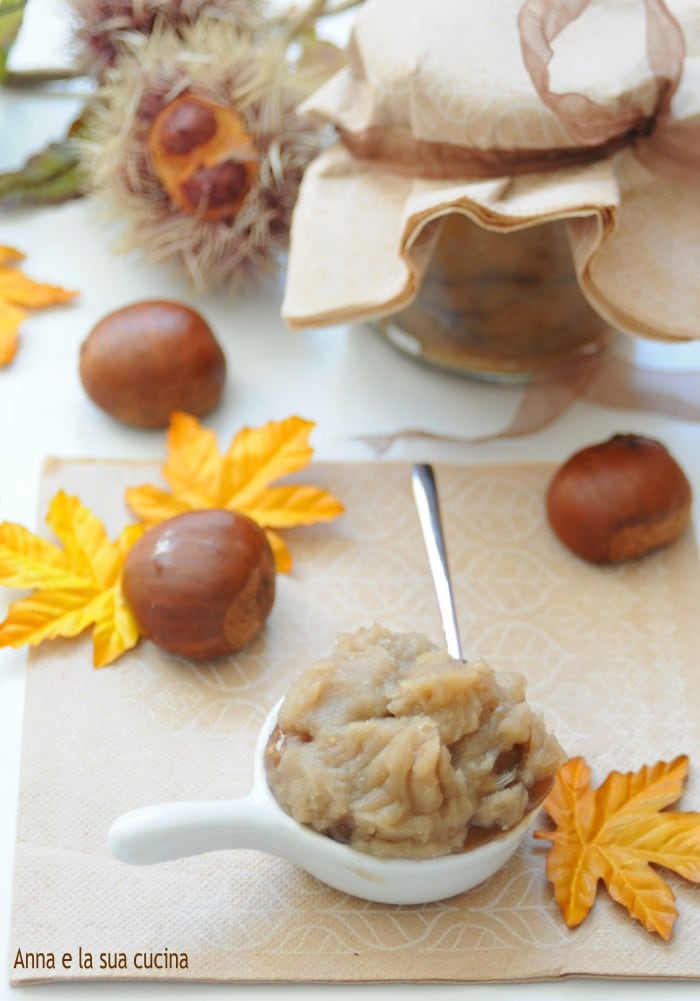Chestnut vanilla jam with brown sugar is a sweet autumn preserve, creamy and fragrant, perfect for breakfast or snack spread on a slice of bread or other, but also perfect for filling our desserts.
It is prepared only with chestnuts without the addition of chocolate, only sugar and vanilla for an extra touch of aroma.
At my house, everyone loves it, especially my son who finished two jars; unfortunately, the only annoying inconvenience is peeling and removing the skins from the chestnuts, otherwise, the process is very simple.
I recommend trying it, even if you make just one jar for tasting it is really delicious and finishes quickly!
YOU MIGHT ALSO BE INTERESTED IN THESE RECIPES

- Difficulty: Easy
- Cost: Cheap
- Preparation time: 1 Hour
- Portions: 3 jars
- Cooking methods: Boiling
- Cuisine: Italian
- Seasonality: Autumn
Ingredients for Chestnut Vanilla Jam
- 1.1 lbs chestnuts
- 1.25 cups Sugar (brown)
- as needed Water
- 1 vanilla (vial)
Tools
- Pot
- Kitchen Robot Cooking chef Kenwood
- Jar glass
- 1 Immersion Blender Kenwood
Preparation of Chestnut Vanilla Jam
For the preparation of the jam, choose nice large chestnuts, start by removing the peel from all the chestnuts. Then immerse them and cook them for a few minutes in hot water to soften the skins.
Drain them and while still hot, perhaps doing it gradually, use a good knife to remove the skins from the chestnuts.
After cleaning all the chestnuts, chop them a bit.
In a kitchen robot or a pot, pour about 1.7 cups of water, bring to a boil and then add the sugar.Once it has dissolved, pour in the chestnuts, cook them slowly, constantly stirring with a wooden spoon until they have softened a little.
At this point, blend them until creamy using an immersion mixer, or another method.Continue cooking slowly for about 30 minutes, keep some hot water aside, if needed add it gradually and pour in the vanilla vial. When the jam has thickened and is nice and creamy, it is ready to be jarred.

Pour the hot jam into the glass jars, already cleaned and previously sterilized.
Seal and close the jars tightly, once closed proceed with the final sterilization, this is needed for good product conservation!Place the closed jars in a pot with boiling water, turn on the stove and boil them for about 15-20 minutes for small and medium jars and 30 minutes for larger ones.
You can also use a pressure cooker for sterilizing the jars, using less water, but a regular pot works fine too, always calculate the minutes after they reach a boil.
Let the jars cool inside the pot, when they are cold check the vacuum seal has occurred correctly: you can press in the center of the lid and if you don’t hear the classic “click-clack” the vacuum has occurred, otherwise change the lid and redo the sterilization or store in the fridge and consume within 2 days.
Dry, date and store the product in the pantry in a cool and dry place protected from light and heat sources, for about 6 months.The chestnut jam can be prepared in a common pot or for those who own a Thermomix or the Kenwood cooking chef.
For other fruit jams or marmalades click the recipes:
mixed tangerine and kumquat marmalade
orange marmalade with Kenwood
strawberry jam
cherry jam
apple jam
pear and chocolate jam
mixed grape jam
green fig jam
quince jam
Anna recommends…
Always do the final sterilization this allows for greater product safety with longer preservation, compared to those who use the vacuum method with jars turned upside down, still hot.
Once opened, consume the jar within 10 days maximum and store the product in the fridge.
For this reason, it is recommended to use small jars to avoid prolonged opening.
Can I add cocoa or chocolate?
Yes, you can enrich and add both.

